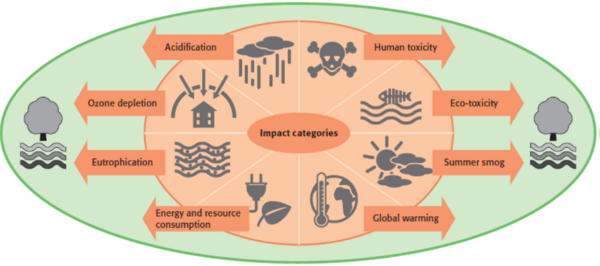The SolACE project is developing a number of cropping innovations, both through new genetics, but also new technologies and management methods. To ensure these innovations deliver impact in the real world, they are being trialled by farmers on real farms. However, to assess their potential impact we need to undertake an integrated assessment of both their economic performance and environmental impacts. To achieve this we use a life cycle assessment approach that accounts for all the physical inputs such as seed, fertiliser, irrigation water and machinery operations and all the marketable outputs such as grain, tubers or straw.
On each of the participating farms, all of the inputs and subsequently outputs will be recorded by the network coordinator, working with the farmer. This data will then be transferred to the integrated farm model (described below), to allow us to undertake the calculations. Each of these inputs has a range of environmental impacts as well as an economic cost.
The environmental impacts are calculated across a range of categories shown in Figure 1, e.g., global warming potential from manufacturing and fuel use, toxicity of substances to humans or the potential for eutrophication of water. Depending on the crop, environmental impacts can then be distributed between the outputs such as grain and straw. For this we use an economic allocation key based on the relevant prices of the grain and straw. Therefore, we generate an environmental footprint for each component, e.g., a carbon footprint for a kilogram of wheat grain.
Further to the physical crop inputs, for the economic assessment we add other relevant inputs such as labour, machinery and fuel usage. This is achieved through the use of standard agricultural contractor costs for the different operations and better aligns the economic calculation with the LCA approach for environmental impacts. Costs will be related to the revenues of selling the products in order to calculate the gross margins.
For each farm and innovation tested, we will assess both the novel approach and the typical practices of the farm, which will act as an informal “control”. Through this comparison, we can make an assessment of the relative performance of the innovation.
From the environmental and economic results of SolACE on-farm trials, we will identify “win win” situations, where there are potential benefits for both the environment and the farmer’s bottom line. However, sometimes there will be trade-offs, even within a category, e.g., reduced irrigation reduces the water footprint, but if the yield declines the carbon footprint may be greater per kg of potatoes.
In summary, the integrated assessment of the innovations tested on-farm within the SolACE project will inform both farmers and scientists of the relative environmental and economic impacts, which together with practical considerations, can guide the adoption of effective management techniques and improved crop varieties.
Further information
Contact
Simon Moakes & Matthias Meier, FiBL Switzerland
Link
shop.fibl.org: Fact sheet "Life cycle assessments of organic food"

 tap and then scroll down to the Add to Home Screen command.
tap and then scroll down to the Add to Home Screen command.